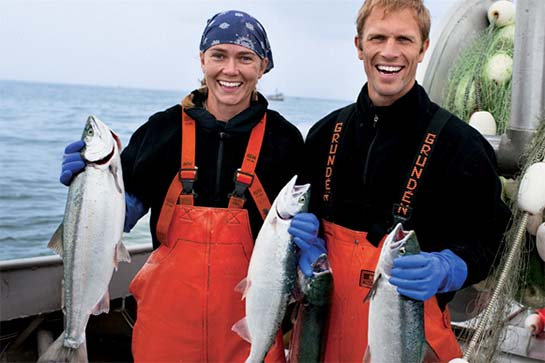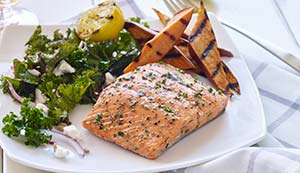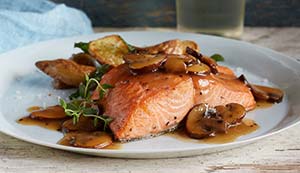The highly anticipated harvest for the five species of wild Alaska salmon kicks off on May 16 with the first of the season sockeyes and kings making their way into retailers and restaurants throughout the USA and beyond shortly thereafter. The fishing season for pink, keta, and coho salmon will follow in late May and continue through October, meaning wild Alaska salmon will be available all summer long.
One of the most popular fish in the country, more than 90 percent of the wild salmon caught in the United States comes from sustainable Alaskan waters. The Alaska Seafood Marketing Institute (ASMI) forecasts that 161 million salmon to be harvested.

Here’s the lowdown on all five species:
- Sockeye – Also known as red salmon, Alaska sockeye is one of the most popular salmon selections due to its deep red color and rich flavor. The firm texture of sockeye makes it well suited for almost all preparation techniques, including grilling, broiling, sautéing, roasting, poaching, steaming and smoking. Alaska sockeye salmon is available frozen year-round and fresh from mid-May through mid-September.
 King – Championed for its size and succulent flavor, King Salmon, also known as Chinook, is the largest of the five Alaska salmon species and also contains the highest fat content. Similar to sockeye, king salmon features rich red flesh and lends itself well to most cooking techniques. Although primarily caught in the summer, some Alaska king salmon is harvested year-round for fresh and frozen availability.
King – Championed for its size and succulent flavor, King Salmon, also known as Chinook, is the largest of the five Alaska salmon species and also contains the highest fat content. Similar to sockeye, king salmon features rich red flesh and lends itself well to most cooking techniques. Although primarily caught in the summer, some Alaska king salmon is harvested year-round for fresh and frozen availability.- Pink – True to its name, Alaska Pink Salmon has rosy pink-colored flesh. The most abundant and affordable of the five Alaska salmon species, pink salmon is known for its delicate flavor and tender texture. Decreased cooking temperatures are recommended when preparing pink salmon because of its lower oil content. Wild Alaska pink salmon is available June through September and frozen year-round.
- Keta – Also known as Silverbrite or Chum, Keta features a mild flavor and pink color. This extremely versatile species is good for smoking, and due to its firm texture, it is a great choice for grilling or roasting. Like pink salmon, it is best to prepare keta at decreased cooking temperatures due to its lower oil content. Wild Alaska keta is available June through September and frozen year-round.
 Coho – Also known as Silver, Alaska Coho lends itself to a host of preparation styles. Coho is the second largest Alaska salmon species and is known for its orange-red flesh, delicate flavor and firm texture. Wild Alaska Coho is available mid-June through late October and frozen year-round.
Coho – Also known as Silver, Alaska Coho lends itself to a host of preparation styles. Coho is the second largest Alaska salmon species and is known for its orange-red flesh, delicate flavor and firm texture. Wild Alaska Coho is available mid-June through late October and frozen year-round.
For recipe ideas, including the Alaska Seafood Marketing Institute’s SWAP Meat collection that puts a healthy twist on classic recipes, and information on Alaska’s wide array of whitefish and shellfish varieties, visit www.wildalaskaseafood.com. Additional information on each Alaska salmon species, nutritional values, harvesting methods and full recipes from Alaska Seafood can be found online in the Ultimate Guide to Wild Alaska Salmon.
About ASMI
Headquartered in Juneau, the Alaska Seafood Marketing Institute is a partnership of the State of Alaska and the Alaska seafood industry engaged in promoting the benefits of wild and sustainable Alaska seafood and providing seafood industry education. The seafood industry is Alaska’s largest private sector employer with nearly 60 percent of all commercial fishery products and 90-95 percent of wild salmon harvested in the US coming from the state.
In addition to wild salmon, Alaska is known for its crab and whitefish varieties, such as cod, sablefish, halibut, pollock, sole and rockfish, and is available frozen year-round. Alaska has been dedicated to sustainable seafood for more than 50 years and is the only state with a Constitution that mandates all seafood be maintained under the sustained yield principle.





